Chapter 19.75
SIGNS
Sections:
19.75.060 Design and construction.
19.75.070 General sign requirements.
19.75.080 Specific sign requirements table.
19.75.090 Specific sign requirements.
19.75.100 Removal of sign for vacant premises.
19.75.110 Nonconforming signs.
19.75.010 Purpose.
The purpose of this chapter is to provide for the reasonable display of signs necessary for public service or the conduct of business. The regulations enacted herein are necessary to protect the safety and welfare of the public and to maintain an attractive appearance in the community. This chapter authorizes and regulates the use of signs visible from a public right-of-way and/or adjacent property to:
A. Balance multiple goals including promoting economic development and creating an attractive community;
B. Provide minimum standards to safeguard life, health, property and the general welfare by regulating and controlling the design, quality of materials, construction, location, electrification and maintenance of all signs and sign structures;
C. Ensure that signs are compatible with adjacent land uses;
D. Protect the public from hazardous conditions resulting from signs that are structurally unsafe, obscure vision of motorists, distract motorists, or interfere with traffic signs and signals;
E. Minimize overhead clutter for drivers and pedestrians;
F. Provide for types and sizes of signs appropriate to the land uses and zoning districts of the City;
G. Encourage well-designed signs that are compatible both with surrounding land uses and the buildings to which they are appurtenant;
H. Provide the public with reasonable means to help them easily and safely locate businesses and other locations in University Place;
I. Recognize free speech rights by regulating signs in a content-neutral manner;
J. Implement the goals and policies of the City of University Place Comprehensive Plan; and
K. Protect property values by encouraging signs that are appropriate in both scale and design to surrounding buildings and landscape and by discouraging a needless proliferation of the number of signs.
(Ord. 741 § 1 (Exh. P), 2020; Ord. 699 § 1 (Exh. A), 2018).
19.75.020 Scope.
This chapter may be referred to as the sign code. This chapter applies to all signs in the City. This chapter regulates the type, size, location and number of signs. This chapter shall be administered by the Director.
(Ord. 741 § 1 (Exh. P), 2020; Ord. 699 § 1 (Exh. A), 2018).
19.75.030 Definitions.
A. General Definitions. Words not defined herein have their common meaning. The terms described below have the following meaning within this chapter:
“Building code” means codes adopted by the City including, but not limited to, Chapter 14.05 UPMC.
“Building Official” means the City official responsible for administration of the building code or a duly authorized deputy.
“Change of use” means a change of business, service, commodity, product or activity that is no longer operating or being offered or conducted on the site.
“Freestanding letters” means a sign comprised of individual letters, characters, or marks, whether fastened directly against a wall or erected upon a steel framework for support.
“Internal illumination” means a source of lighting concealed entirely within a sign that illuminates the sign graphics by the transmission of light through a translucent or semi-translucent material.
“Landscaping” means any material used as a decorative feature for a sign, such as shrubbery, native vegetation, grass, flowers, decorative groundcover, planting materials, planter boxes, or brickwork. Landscaping does not include any material that displays advertising copy.
“Marquee” means a permanent-roofed structure attached to and supported by a building to provide protection from the weather.
“Nonstructural trim” means the molding, battens, caps, nailing strips, latticing, and cutouts attached to a sign structure.
“Periphery of right-of-way” means within a right-of-way but at the edge of the right-of-way so as not to interfere with vehicular and/or pedestrian traffic including maintaining sight distance. Periphery of right-of-way does not include landscape areas between a street and sidewalk, within a median or roundabout.
“Sign owner” means any person with a legally protected interest in a sign or a sign structure including, but not limited to, a legal owner of a sign, a sign user, and the owner or lessee of property on which a sign or sign structure is located.
“Sign structure” means the supports, uprights, braces, and framework for a sign.
“Silhouette lighting” means lighting being emitted from a pan-channel sign graphic which has the open side of the channel facing the wall or sign face it is mounted to, thereby silhouetting the sign graphics. This is sometimes called “halo lighting.”
“Special event” means events regulated under Chapter 5.10 UPMC.
“Tenant” for the purposes of this section shall mean an occupant of a premises upon which a sign is located or, in the case of an off-premises directional sign, an occupant of a premises within 650 feet of the freestanding sign on which that occupant advertises.
B. Types of Signs. The terms described below have the following meanings within this chapter:
“A-board” or “sandwich board sign” means a temporary portable sign, usually constructed of two pieces of wood, plastic or similar material attached to each other at the top edge, which stands like an “A” or is worn by a person such that one sign face is visible on either side of the sign.
“Address sign” means a sign displaying only an address.
“Awning sign” means a sign attached to an awning, canopy or other similar structure that is comprised of fabric, plastic or similar materials and is located over an entrance, a window or an outdoor service area at a place of business. An awning sign is a type of wall sign. A marquee sign is an awning sign.
“Banner” means a temporary sign usually made of cloth, nylon or plastic that is hung by rope, cable or similar materials from a building or another sign structure.
“Billboard” means a preprinted or hand-painted changeable advertising copy sign which directs attention to businesses, commodities, services, or facilities which are not primarily sold, manufactured, or distributed from the property on which the sign is located. The term “billboard” includes both the structural framework that supports a billboard and any billboard faces attached thereto.
“Bus shelter signs” means advertising signs mounted to bus shelters in the right-of-way.
“City gateway sign” means a sign constructed and maintained by the City to welcome citizens and visitors to our community. Gateway signs are usually installed along major arterial streets leading into our community.
“Commercial sign” means a sign erected by a business or other person engaged in the exchange of goods and services.
“Digital sign” means an electronic sign with monochrome LED (light emitting diodes) text, graphics or symbols over a black, nonilluminated background.
“Directional sign” means a sign solely to direct pedestrian or vehicular traffic while entering, exiting, or traveling on the property where the sign is located.
“Electronic message center sign” means an electronic sign having variable message, color and/or graphic presentation capability that can be electronically programmed by computer or handheld device from a remote location. EMCs typically use light emitting diodes (LEDs) or liquid crystal display (LCD) as a lighting source.
“Event sign” means a temporary sign advertising and/or providing direction to an event with a limited duration of time. Events include yard sales and special events.
“Feather sign” means a temporary sign made of paper, cloth, flexible plastic or fabric of any kind with only such material for backing. Feather signs are generally a sign attached to a support post. Feather signs are also known as feather flags, banner flags, bow flag, wind feather and tear drop signs.
“Flashing sign” means an illuminated sign which lights suddenly or intermittently. A strobe light used to attract attention to a business is a flashing sign.
“Freestanding sign” means a sign supported on a structure used exclusively for the support of the sign or for a group of signs, including pedestal, pylon, pole, and monument signs.
“Hand crafted” means made by hand as opposed to mass production using machinery.
“Home occupation sign” means a sign advertising a home occupation.
“Identification sign” means a sign located in an R1, R2, MF-L, MF-H, POS, or PFO zone identifying an institutional, multifamily use or subdivision.
“Incidental sign” means a sign that is not visible either from a right-of-way or off of the property on which the sign is located. Incidental signs typically inform the public about goods, facilities, or services available on the premises including, but not limited to, restrooms, hours of operation, acceptable credit cards, property ownership or management, phone booths or recycling containers.
“Menu sign” means a sign at the entrance to a drive-through lane at a restaurant or an automobile service facility. Examples of such signs may include those signs which list menu items or services for sale at the establishment and may include those signs at car washes or automobile lubrication facilities that typically display a menu sign.
“Monument sign” means a freestanding sign that is attached directly to the ground with a decorative base made of wood, masonry or other similar material. Monument signs may have posts comprised of wood, masonry, or metal so long as the posts are completely surrounded by the decorative base.
“Mural” means a large decorative image, not an advertisement, which is painted or drawn on an exterior wall of a structure.
“Nameplate” means a sign displaying only an occupant’s name or the name or address of premises.
“Noncommercial sign” means any sign that is not a commercial sign. This definition includes signs regarding noncommercial fund raising or membership drive activities, or promoting noncommercial or nonprofit entities or groups.
“Nonconforming sign” means a sign that does not conform to the provisions of this chapter.
“Off-premises directional sign” means a sign that contains no advertising of a commercial nature that directs pedestrian or vehicular traffic circulation to a facility, service, or business located on other premises within 650 feet of the sign.
“Off-premises sign” means a sign advertising a business, product, activity or service that is not sold at the site where the sign is located.
“Painted sign” means a sign painted on a wall, fence or other structure and not lighted by internal illumination.
“Pan-channel” means a sign graphic that is constructed of a three-sided metal channel, usually having a light source contained within the channel. The open side may face inward, resulting in silhouette lighting, or it may face outward to allow full illumination. The open side of the channel may be covered with a translucent material.
“Pole sign” means a sign hung from or supported by vertical standing pipe(s), wood beam(s) or other material(s) that are affixed to the ground at one end and to the sign at the other end if the support(s) are clearly visible.
“Portable sign” means a sign not permanently attached to the ground or to another permanent structure, or a sign designed to be transported including, but not limited to, signs designed to be transported by means of wheels whether by trailer or on its own wheels even though the wheels of such sign may be removed. This definition includes A-boards, T signs, and menu or sandwich signs and mobile reader boards.
“Projecting sign” means a sign affixed at an angle or perpendicular to the wall of any building in such a manner to read at an angle or perpendicularly to the wall on which it is mounted.
“Reader board sign” means a sign with characters, letters or illustrations that can be changed or rearranged by hand without altering the face or surface of the sign.
“Real estate sign” means an on-site temporary sign directing attention to the availability for sale, lease, or rent of a particular premises.
“Residential/commercial development sign” means a sign identifying a new subdivision or commercial project under construction.
“Residential sign” means a sign erected on a lot in a residential zone.
“Revolving sign” means a sign that revolves or partially revolves by mechanical means.
“Roof sign” means a sign erected upon or above a roof or parapet of a building or structure.
“Sign” means any device, fixture, or placard that is visible from a public right-of-way or surrounding properties and uses graphics, symbols, logos, or written copy for the purpose of advertising or identifying any establishment, product, goods, service or activity. A sign may have multiple faces and advertise multiple establishments, businesses, products, services, or activities. This definition does not include any flag of any country, state or local jurisdiction. Unless the context clearly provides to the contrary, a “sign” as used in this chapter also includes the “sign structure.”
“Sign structure” means all of the interrelated parts and materials, such as beams, poles, braces, apron, catwalk, and stringers, that are used, designed to be used, or are intended to be used to support or display a sign.
“Special displays” means displays of merchandise, animals, balloons, cars, airplanes, posters, pennants, or streamers, searchlights, flashing signs, clusters of flags, strings of twirlers or propellers, flares, and other displays of a carnival nature or other objects used to attract attention for purposes of advertising.
“Street banners – decorations” means any street banners, decorations, and/or other similar items located in the City right-of-way.
“Suspended sign” means a sign attached to and hanging from the underside of a canopy, awning, porch ceiling, or similar shelter, or hanging from the beams or structures supporting such shelters.
“Temporary commercial use sign” means a temporary on-premises sign used for the purpose of advertising or identifying a temporary use permitted in accordance with Chapter 19.35 UPMC.
“Temporary sign” means any sign, banner, pennant, valance, or advertising display constructed of cloth, canvas, light fabric, cardboard, wallboard or other similar materials, with or without a frame, intended to be displayed for a limited time only. A-boards, banners, portable, special display and event signs shall be considered temporary signs.
“Time and temperature sign” means a digital sign displaying solely the time and temperature.
“Wall sign” means a sign erected against the wall of a building or other structure with the sign face parallel to the plane of the wall. Examples of wall signs include a marquee, a painted sign or a sign supported by a fence.
“Window” means an opening in the wall of a building for the admission of light and/or air that is usually closed by casements or sashes containing transparent materials (such as glass) and may be capable of being opened or shut and allows people to see through. For the purposes of this chapter, a window shall include all window components of a standalone window or a window system consisting of more than one pane and window components including but not limited to casings, jambs, mullions, rails, sashes, sills and stiles.
“Window masking” means covering a window with a sign or otherwise making the window fully or partially opaque.
“Window sign” means a sign on a window or located inside and in such close proximity to the window so as to be easily and readily viewed from outside the window. Window signs include images of products or services offered. Signs visible through a window and less than 36 inches from the window are considered window signs.
“Yard sign” means a sign with wire or wood support post(s). Wire supports usually consist of at least two tines that can be inserted into the sign. The tines on the other end of the frame can be inserted into the ground. See Figure 2.
Figure 1. Sign Types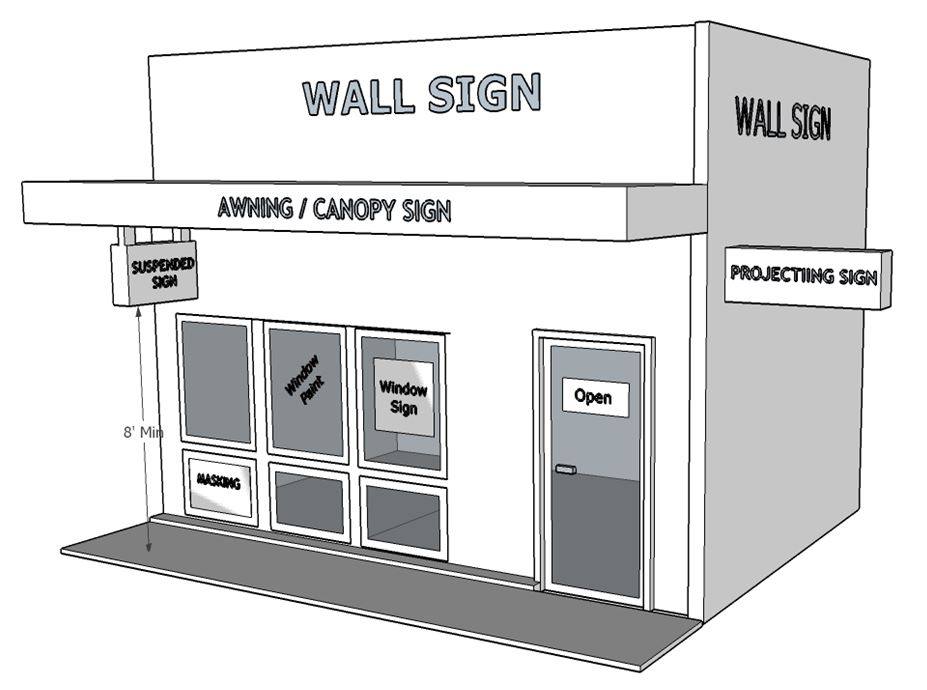
Figure 2. Yard Signs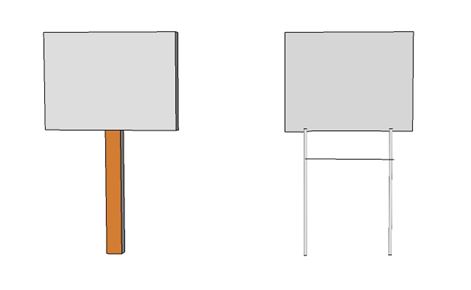
(Ord. 741 § 1 (Exh. P), 2020; Ord. 699 § 1 (Exh. A), 2018).
19.75.040 Permits required.
A. Sign Permits. Except for those signs exempt by law, this chapter, or not expressly covered by this chapter, it shall be unlawful to erect or display a sign in the City without a sign permit issued by the Department. Nothing in this chapter modifies any provision of Chapter 14.05 UPMC, which requires a building permit to erect, modify or demolish certain signs and sign structures.
B. Temporary Sign Permits. The Director may issue temporary sign permits and attach reasonable conditions to the issuance of a permit as may be necessary to ensure timely discontinuance of the use and to ensure substantial compliance with this chapter.
C. Applications for Sign Permits. Any person submitting an application for a sign permit or a temporary sign permit shall make application on forms provided for that purpose at the Department.
D. Additional Information. The Director may require the filing of plans or other pertinent information as necessary to ensure compliance with this chapter.
E. If the application is denied, the Director must provide a list of reasons for the rejection in writing. This decision is subject to appeal to the City of University Place Hearings Examiner by filing an appeal, with the City Clerk, within 10 days of the date of such decision.
(Ord. 741 § 1 (Exh. P), 2020; Ord. 699 § 1 (Exh. A), 2018).
19.75.050 Permit issuance.
A. Permit Issuance. It shall be the duty of the Director, upon the filing of an application for a permanent sign permit or a temporary sign permit, to review the application and to issue, issue with conditions, or deny the permit, or request additional information to process the application, in accordance with the provisions of this chapter. Any application that complies with all provisions of this code must be approved.
B. Permit Fees. Required fees are set forth in the City’s fee resolution as adopted or hereafter amended.
C. Temporary Signs. All temporary signs must be removed within three working days after the expiration of the permit. If the applicant fails to remove the sign in the time required, the applicant will not be eligible for another temporary sign permit for 12 months.
D. A sign permit shall be processed as a Type I permit under UPMC Title 22.
(Ord. 741 § 1 (Exh. P), 2020; Ord. 699 § 1 (Exh. A), 2018).
19.75.060 Design and construction.
All signs shall be erected in accordance with the following design and construction standards and other requirements of this chapter:
A. Obstructing Signs. No sign or sign structure shall be constructed in such a manner or at such location that it will obstruct access to any fire escape or other means of ingress or egress from a building or any exit corridor, exit hallway, or exit doorway. No sign or supporting structure shall cover, wholly or partially, any window or doorway in any manner that it will substantially limit access to the building in case of fire.
B. Visibility. No sign or sign structure shall be placed or erected in any place or manner whereby reason of its position it will obstruct safe visibility for vehicular or pedestrian traffic.
C. Construction Standards for Permanent Signs. No sign shall be constructed, erected, or maintained unless the sign and sign structure is so constructed, erected, and maintained as to be able to withstand the wind, seismic and other requirements as specified in the building code. Permanent freestanding signs shall also be subject to the following design standards:
1. Structural Components. To the maximum extent possible, signs should be constructed and installed so that angle irons, guy wires, braces and other structural elements are not visible. This limitation does not apply to structural elements that are an integral part of the overall design such as decorative metal or wood.
2. Dimensional and Design Standards.
a. Pedestal, Pole or Pylon Signs. The following drawings illustrate the dimensional standards for pedestal, pole or pylon signs:
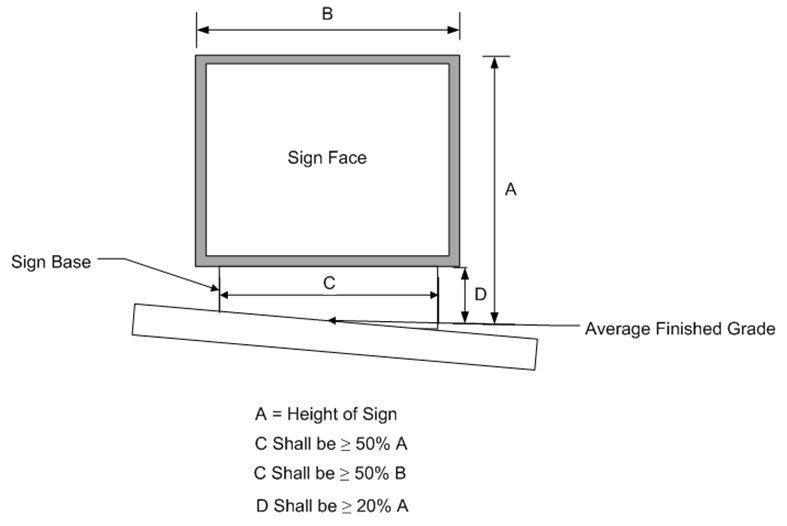
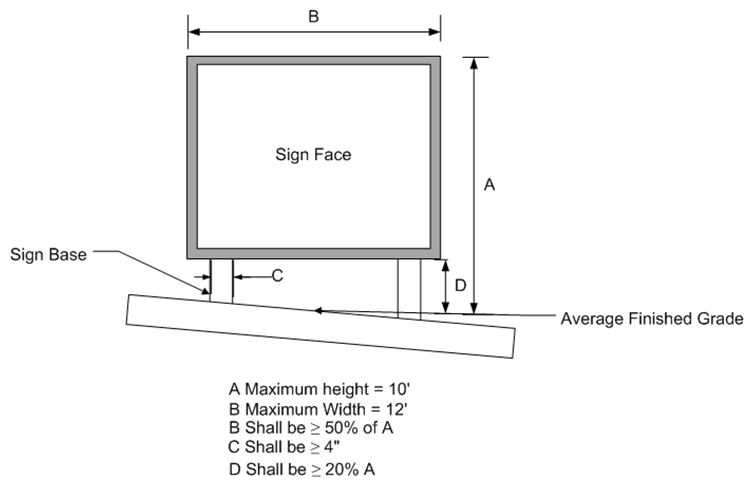
b. Monument Signs. The following figures illustrate the dimensional standards for monument signs: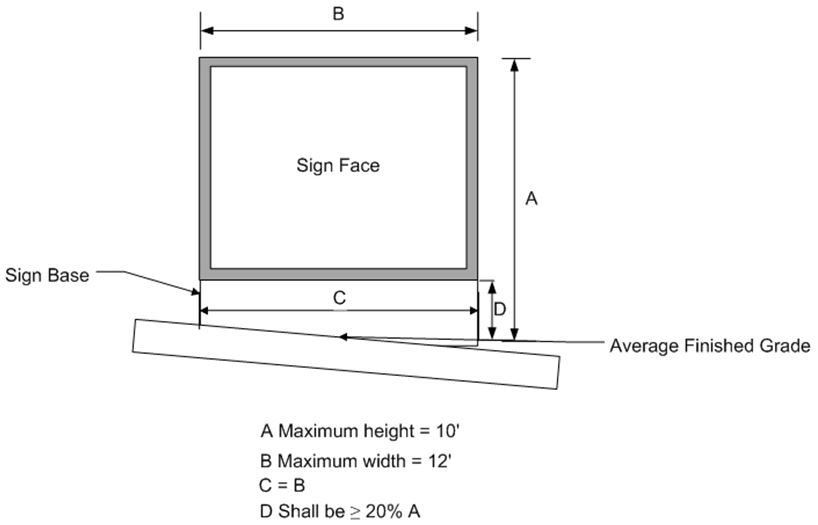
3. Design Criteria.
a. Sign Base. The base of the sign must be constructed of landscape materials such as brick, stucco, stonework, textured wood, tile or textured concrete or materials that are harmonious with the character of the primary structures on the subject property. Materials that differ from the primary structure are subject to the Director’s approval. No visible gap shall be allowed between the sign base and the finished grade or between the sign face or cabinet and the sign base except as provided in this chapter.
b. Except as provided in this chapter, all pole or pylon signs shall be supported by two or more supports.
c. Sign Face. The color, shape, material, lettering and other architectural details of the sign face must be harmonious with the character of the primary structure.
D. Minor Deviations. Minor deviations from the dimensional standards for signs, except for maximum sign height, may be approved by the Director upon finding that the resulting sign does not significantly change the relative proportion of the sign base to the sign face.
E. Electric Signs. Electric signs shall be constructed and inspected in accordance with applicable electrical codes.
F. Public Right-of-Way. Signs in the public right-of-way shall be regulated by UPMC Title 13 and require a valid right-of-way use permit pursuant to UPMC Title 13. Any sign located in a public right-of-way without a valid right-of-way permit is hereby declared a public nuisance. Any unlawful sign may be removed from a public right-of-way immediately.
G. Planter Boxes – Bumper Guards – Shrubs – Plants. No planter box or bumper guard designed to protect or beautify a sign structure shall extend beyond the property line. Planter boxes shall not be more than 36 inches above average finished grade.
H. Utility Lines – Clearance. Horizontal and vertical clearance of signs or sign structures from utility lines shall be determined by the appropriate service provider.
(Ord. 741 § 1 (Exh. P), 2020; Ord. 699 § 1 (Exh. A), 2018).
19.75.070 General sign requirements.
The size and placement of signs are regulated to maintain a safe and attractive community and to facilitate attention to their messages. The following standards are intended to aid the sign user, sign maker and the Department in determining the maximum size and appropriate location of permitted signs:
A. General Sign Requirements.
1. Area of Signs.
a. The area of a sign means the area within a continuous perimeter enclosing the outer limits of the sign face, but not including structural elements which are not a part of the display.
b. When two identical sign faces are placed back to back, the sign area shall be computed by the measurement of one of the sign faces. No more than two faces are permitted per freestanding sign. The area of a spherical, cubical or polyhedral sign equals one-half the total surface area.
2. Area of Freestanding Letters. Freestanding letters and/or characters forming a sign or message shall be considered to occupy two-thirds of the combined overall background area.
3. Height of Signs. Maximum height of all freestanding signs or any part of the freestanding sign structure shall be 10 feet above average finished grade. Sign height shall be measured from the average finished grade at the sign foundation. The average finished grade for signs on grades lower than the adjacent right-of-way shall be considered the same as the average grade of the adjacent right-of-way. See the diagram following subsection (A)(8) of this section for grade exceptions.
4. Width of Signs. The maximum width of a freestanding sign structure shall be 12 feet. Sign width shall be measured on the face side of the sign from one side of the face or any part of the sign structure to the farthest point on the opposite side of the face or part of the sign structure.
5. Setbacks for Signs. All signs are permitted a zero-foot setback, except as provided in this chapter, provided the owner demonstrates to the City by reasonable evidence that the sign will not obstruct the clear sight zone as specified in UPMC Title 13.
6. Illumination. External sign illumination shall be directed only towards the sign face or freestanding letters and shall be shielded in ways to prevent light and glare on adjacent properties. Backlit sign backgrounds and neon signs are prohibited on commercially zoned property between 35th Street West and 38th Street West.
7. Raceways. Raceways shall be hidden or painted to match the building on which the sign is located.
8. Grade Exception. When the elevation at the base of a freestanding sign is at least five feet below the elevation of the adjacent road, a single pole may be used to support the sign provided the portion of the sign above the elevation of the adjacent roadway has the appearance of a monument sign. See figure below.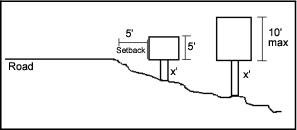
9. Maintenance of Signs. All signs shall be maintained in a safe condition and in good repair. Any sign that is damaged shall be restored to a safe condition and good repair no later than 90 days after the event that caused the damage. Failure to maintain a sign in a safe condition and in good repair shall be grounds for revocation of a sign permit.
10. Establishment of Property Lines. It shall be the responsibility of the property owner or an authorized representative to establish and clearly mark out any property line from which a sign setback measurement shall be taken. In the event of a dispute or discrepancy, the Director may order an independent survey to ensure compliance with this chapter. The survey cost shall be charged to the sign applicant.
(Ord. 741 § 1 (Exh. P), 2020; Ord. 699 § 1 (Exh. A), 2018).
19.75.080 Specific sign requirements table.
The following requirements apply to specific sign types. The Director may prescribe reduced area and height, more controlled illumination and greater setback as a condition of any special use permit approval.
|
Type of Sign |
Permit Required |
Area (sq. ft.) |
Height (feet) |
Setback1 |
Number of Signs |
Other Requirements3 |
|---|---|---|---|---|---|---|
|
Address |
No |
3 |
10 |
0 |
2 |
Numbers and letters ≤ 10'' high |
|
Banners |
Temporary |
24 |
|
0 |
1 |
For nonresidential uses only |
|
Directional |
No |
6 |
3 |
0 |
|
1 per entrance |
|
Event3 |
No |
6 |
10 |
|
6 |
1 on premises and 5 at periphery of rights-of-way |
|
Home Occupation |
No |
2 |
10 |
|
1 |
May be freestanding, placed on the primary structure or in a window |
|
Identification |
Permanent |
36 |
10 |
0 |
1 – 3 |
1 per entrance or 2 at main entrance |
|
Incidental |
No |
2 |
|
|
|
|
|
Nameplates |
No |
6 |
|
0 |
|
|
|
Nongovernment Flags |
No |
20 |
30 |
5 |
1 |
Government flags are exempt |
|
Official Legal Notices |
No |
|
|
0 |
|
Notices issued and posted by public agency or court |
|
Real Estate |
No |
12 |
6 |
|
1 per tax lot |
Nonilluminated if freestanding |
|
Residential/Commercial Development Sign |
Temporary |
32 |
10 |
0 |
1 per street front |
Parcel must be > 0.5 acres |
|
Residential Open House A-Boards |
No |
6 |
5 |
0 |
1 on premises and 5 at periphery of rights-of-way |
Permitted during daylight hours only; a realtor, seller or agent must be on the property |
|
Plaques, Tablets, or Inscriptions |
No |
3 |
3 |
0 |
|
|
|
Temporary Noncommercial2 |
No |
4 |
3 |
|
|
At periphery of right-of-way |
Notes:
1. The sign owner must provide proof that the sign will not adversely impact the clear-view triangle as specified in UPMC Title 13.
2. Additional requirements are listed in UPMC 19.75.090, Specific sign requirements.
3. See Chapters 19.35 UPMC, Temporary Uses, and 5.10 UPMC, Special Events, for additional requirements.
|
Type of Sign |
Permit Required |
Area (sq. ft.) |
Height (feet) |
Setback1 |
Number of Signs |
Requirements2 |
|---|---|---|---|---|---|---|
|
A-Board |
Temporary |
12 |
5 |
|
1 per 50' of frontage |
See UPMC 19.75.090(C) |
|
Address |
No |
|
|
0 |
|
Numbers and letters ≤ 10" high |
|
Awning |
Permanent |
≤ 15% of facade |
|
|
|
|
|
Banners |
Temporary |
24 |
|
0 |
2 |
See UPMC 19.75.090(C) |
|
Billboards |
Prohibited |
|
|
|
|
|
|
Digital |
Permanent |
|
|
|
0 |
See UPMC 19.75.090(A) |
|
Directional |
No |
6 |
3 |
0 |
|
1 per entrance or exit |
|
Electronic Message Center2 |
Permanent |
See freestanding signs |
10 |
0 |
1 |
Must be set back at least 100' from center of any controlled intersection |
|
Event3 |
No |
6 |
10 |
|
6 |
1 on premises and 5 at periphery of right-of-way |
|
Feather |
Temporary |
24 |
10 |
0 |
1 |
See UPMC 19.75.090(C) |
|
Flags |
No |
20 |
30 |
5 |
1 |
Government flags are exempt |
|
Freestanding Single Tenant Prohibited on Market St. W., Market Square and Market Ct. W. |
Permanent |
32 |
10 |
0 |
1 – 3 |
1 abutting street of highest classification; if > 300' street frontage, a second sign placed at least 100' from first sign is permitted; an additional sign is permitted on a secondary street |
|
Freestanding Two to Five Tenants Prohibited on Market St. W., Market Square and Market Ct. W. |
Permanent |
40 |
10 |
0 |
1 – 3 |
1 abutting street of highest classification; if > 300' street frontage, a second sign placed at least 100' from first sign is permitted; an additional sign is permitted on a secondary street |
|
Freestanding Six or More Tenants Prohibited on Market St. W., Market Square and Market Ct. W. |
Permanent |
50 |
10 |
0 |
1 – 3 |
1 abutting street of highest classification; if > 300' street frontage, a second sign placed at least 100' from first sign is permitted; an additional sign is also permitted on a secondary street |
|
Off-Premises Directional Sign |
Permanent |
See Req. |
10 |
0 |
1 |
Allowed only for establishments without arterial frontage |
|
Plaques, Tablets, or Inscriptions |
No |
3 |
10 |
0 |
1 |
|
|
Incidental |
No |
2 |
|
|
|
|
|
Murals |
No |
|
|
|
|
Provided the mural does not meet the definition of a sign |
|
Nameplates |
No |
3 |
|
0 |
|
|
|
Official Legal Notices |
No |
|
|
0 |
|
Notices issued and posted by government agency or court |
|
Projecting |
Permanent |
20 |
Height of building |
0 |
1, or 2 if second sign is located on a second wall of a corner space |
See UPMC 19.75.090(L) |
|
Promotional |
Temporary |
|
|
5 – 20 |
No limit |
Setback 5' from property lines, 20' from intersections. Allowed for up to 5 days |
|
Real Estate |
No |
12 |
6 |
|
1 per tax lot |
Nonilluminated |
|
Residential/Commercial Development Sign |
Temporary |
32 |
10 |
0 |
1 per street front |
Parcel must be > 0.5 acres |
|
Residential Open House A-Boards |
No |
6 |
10 |
0 |
1 per street frontage; 5 off premises |
Permitted during daylight hours only; a realtor, seller, or agent must be on property |
|
Roof |
Permanent |
≤ 15% of facade |
See Req. |
0 |
|
See UPMC 19.75.090(H) |
|
Suspended Sign |
Permanent |
7 |
Min. 8 clear |
2 |
1 per business |
12" maximum height |
|
Temporary |
Temporary |
|
|
0 – 5 |
3 per business |
See UPMC 19.75.090(C) |
|
Temporary Use |
Temporary |
12 |
|
|
1 A-board |
On premises display for period of temporary use only |
|
24 |
1 banner |
|||||
|
Wall |
Permanent |
≤ 15% of facade |
|
|
|
18'' maximum thickness |
|
Window |
Temporary |
20% of window |
|
0 |
|
See UPMC 19.75.090 |
|
Window Masking |
Permanent |
|
|
0 |
|
See UPMC 19.75.090 |
1. The sign owner must provide proof that the sign will not adversely impact the clear-view triangle as specified in UPMC Title 13.
2. Additional requirements are listed in UPMC 19.75.090, Specific sign requirements.
3. See Chapter 19.35 UPMC, Temporary Uses, and Chapter 5.10 UPMC, Special Events, for additional requirements.
Exemption from the sign permit provisions of this chapter shall not be deemed to grant authorization for any sign constructed, erected or located in any manner in violation of the provisions of this chapter or any other laws or ordinances of the City or the State of Washington, including the prohibition against placing signs upon City right-of-way.
(Ord. 741 § 1 (Exh. P), 2020; Ord. 699 § 1 (Exh. A), 2018).
19.75.090 Specific sign requirements.
A. Digital Signs. The purpose of this section is to regulate how digital signage technology might be applied to sign types otherwise permitted by this chapter. It is not intended to allow more signs or larger signs than otherwise permitted by this chapter.
1. One digital sign is allowed per 100 feet of street frontage in nonresidential zones.
2. Maximum luminance of not more than 0.2 foot-candles between off and solid-message at night shall be measured in accordance with subsection (A)(3) of this section. All permitted digital signs shall be equipped with a sensor or other device that automatically determines ambient illumination and is programmed to automatically dim according to ambient light conditions.
3. Electronic Message Center (EMC) Illumination Measurement Criteria. The illuminance of an EMC shall be measured with an illuminance meter set to measure foot-candles accurate to at least two decimals. Illuminance shall be measured with the EMC off, and again with the EMC displaying a white image for a full color-capable EMC, or a solid message for a single-color EMC. All measurements shall be taken as close as practical to a perpendicular plane of the sign at the distance determined by the total square footage of the EMC as set forth in the Sign Area versus Measurement Distance table below.
|
AREA OF SIGN |
MEASUREMENT |
|---|---|
|
10 |
32 |
|
15 |
39 |
|
20 |
45 |
|
25 |
50 |
|
30 |
55 |
|
35 |
59 |
|
40 |
63 |
|
45 |
67 |
|
50 |
71 |
* For signs with an area in square feet other than those specifically listed in the table (i.e., 12 sq. ft., 400 sq. ft., etc.), the measurement distance may be calculated with the following formula:
![]()
4. No motion allowed except for instantaneous change of message.
5. Minimum hold between messages: eight seconds plus one-and-one-half-second transition fade.
6. Programming. To ensure that digital signs are programmed and continue to operate according to local standards, digital signs shall be designed for local on-site control and programming only.
B. Electronic Message Center (EMC) Signs. The purpose of this section is to regulate how EMC signage might be applied to freestanding signs permitted by this chapter. It is not intended to allow more signs or larger signs than otherwise permitted by this chapter.
1. Where Allowed. Electronic message center (EMC) signs are only allowed in the Neighborhood Commercial zone.
2. Maximum luminance of not more than 0.2 foot-candles between off and solid-message at night shall be measured in accordance with subsection (B)(3) of this section. All EMCs shall be equipped with a sensor or other device that automatically determines ambient illumination and is programmed to automatically dim according to ambient light conditions.
3. Electronic Message Center (EMC) Illumination Measurement Criteria. The illuminance of an EMC shall be measured with an illuminance meter set to measure foot-candles accurate to at least two decimals. Illuminance shall be measured with the EMC off, and again with the EMC displaying a white image for a full color-capable EMC, or a solid message for a single-color EMC. All measurements shall be taken as close as practical to a perpendicular plane of the sign at the distance determined by the total square footage of the EMC as set forth in the Sign Area versus Measurement Distance table (subsection (A)(3) of this section).
4. Motion Limits. No motion except for a fade-in of the next message with the fade transition being no more nor less than one and one-half seconds. Fade transition is required rather than instantaneous message changes to avoid sudden or startling flashes of light.
5. Minimum hold between messages: eight seconds, plus one-and-one-half-second transition fade.
6. Programming. To ensure that EMC signs are programmed and continue to operate according to local standards, EMC signs shall be programmed on site only. Remote programming in an off-site location is prohibited.
7. Existing EMC signs legally established prior to the effective date of the ordinance codified in this chapter that are nonconforming to the preceding operational standards shall be made compliant within 90 days of written notice to the owner of legally established EMC signs.
C. Temporary Commercial Signs.
1. Three signs per tenant may be displayed for the duration of the temporary use or event for which they are intended but not for longer than 60 days in a year, except as allowed under subsection (C)(7) of this section.
2. Signs shall be removed at the close of each business day.
3. Signs must be removed within three working days after the expiration of the permit, or the event. Failure to remove signs will forfeit use of a temporary sign permit for a period of 12 months.
4. Signs may not be permanently attached to the ground, building, or other structure.
5. Signs shall be located on private property and 20 feet from intersections.
6. Temporary signs (including feather signs) except banners are prohibited along Bridgeport Way between 35th St. West and 42nd St. West. Signs are prohibited along 40th St. West on commercially zoned properties.
7. Temporary commercial freestanding hand crafted signs are allowed on Market Place West, Market Square and Market Court West under the following requirements:
a. Signs can be displayed year-round during business hours and must be located in front of the business.
b. One sign allowed per business.
c. Signs can be placed on private property or the right-of-way within five feet of the building. The main pedestrian pathway must be maintained.
d. A temporary sign permit is required to be renewed annually.
e. Signs shall be hand crafted and unique in nature. Signs constructed of plastic are strongly discouraged (see definition).
Examples of allowed signs:
Examples of prohibited signs: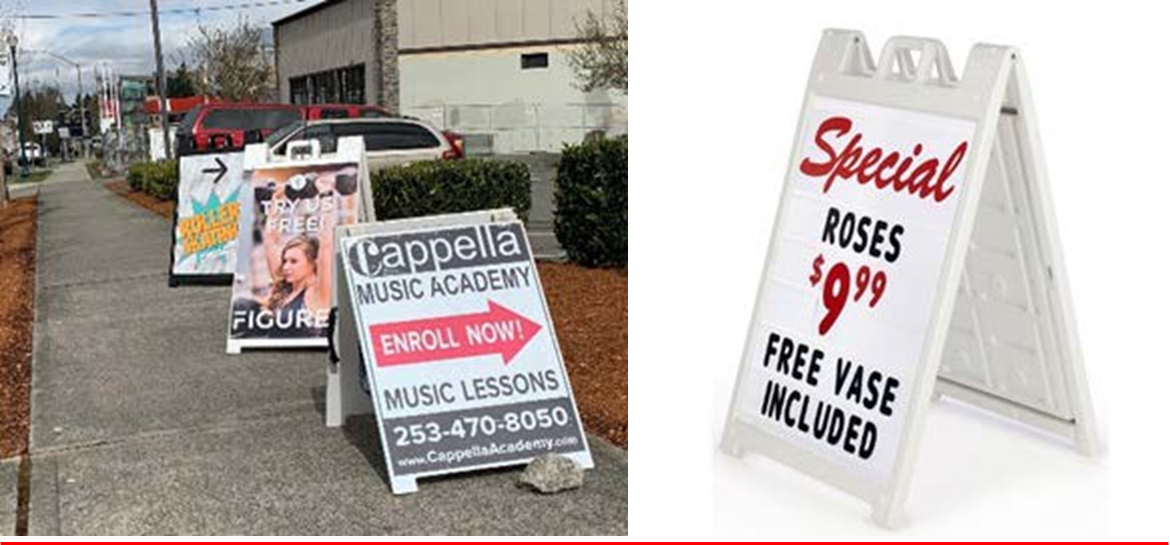
f. Signs are intended for primary visibility of pedestrians along the sidewalk and not the vehicles from the street.
D. Temporary Residential/Commercial Development Sign.
1. One double-faced sign is permitted per street front.
2. No sign shall exceed 32 square feet in surface area or 10 feet in height.
3. Signs may only be erected in conjunction with an issued building or land use permit.
4. Signs must be removed when the last lot is sold in a subdivision or upon final occupancy approval of a commercial development.
E. Temporary Noncommercial Signs.
1. No sign permit is required to post a noncommercial temporary sign in the public right-of-way or on private property if it meets the requirements in this section and in the following table. Noncommercial temporary signs not conforming to the regulations of this section may be approved through a right-of-way permit.
2. Signs shall be placed at the periphery of the right-of-way. On roads that only have a shoulder and do not have a sidewalk, noncommercial temporary signs must be placed beyond the edge of the asphalt, and may not be placed so that any part of the sign extends over the asphalt.
3. Noncommercial temporary signs shall not be placed in a manner that negatively affects the health of trees, shrubs, or other landscaping.
4. Placement of off-premises noncommercial temporary signs on private property is subject to the landowner’s authorization.
F. Noncommercial Signs in Right-of-Way.
|
Sign Type |
A-Board |
Yard Sign |
|---|---|---|
|
Maximum Size |
6 sq. ft. |
4 sq. ft. |
|
Maximum Height |
3.5' |
3' |
|
Duration |
5 consecutive days |
180 days |
G. Awning – Canopy – Marquee.
1. Awnings shall project not less than three feet and not more than seven feet from the face of the supporting building, when over public property.
2. No portion of any awning or canopy shall extend nearer than two feet to the face of the nearest curbline.
3. Area of an awning or canopy sign is counted in the maximum area for all signs on a facade, including wall, window and roof signs combined.
H. Roof Signs. Roof signs shall not project above any roof line, soffit or parapet. See examples of acceptable and unacceptable roof signs below. Area of a roof sign is counted in the maximum area for all signs on a facade, including wall, window and awning signs combined.
Acceptable Roof Signs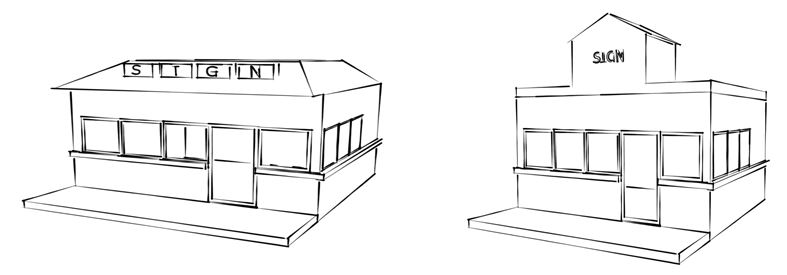
Unacceptable Roof Signs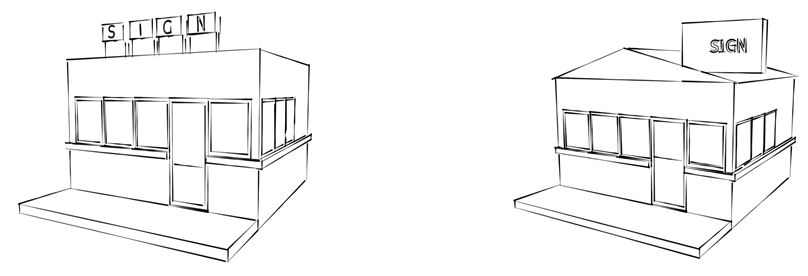
I. Yard Sale Signs. Off-premises signs posted at locations away from the location(s) of the sales are subject to the following provisions:
1. The signs may be placed adjacent to the right-of-way with the property owner’s permission.
2. Yard sale signs shall not be posted sooner than 5:00 p.m. on the day prior to the sale and shall be removed immediately following the end of the sale.
3. Yard sale signs must include the address where the yard sale is located and a date or dates of the sale.
4. Signs for yard sales shall not be allowed for more than four successive calendar days in a 30-day period and shall be limited to advertising not more than three yard sale events in the same calendar year at the same location.
5. A fine of $100.00 per yard sale sign which exceeds these provisions may be levied against the property owner where the sales are held.
J. Window Sign. Window signs displayed for seven days or less are considered temporary signs. Window signs displayed for more than seven consecutive days are considered permanent wall signs and subject to the total maximum wall signage area.
K. Window Masking.
1. Window masking covering 100 percent of the window shall not extend more than 36 inches above sidewalk grade to allow visibility into and out of businesses.
2. Window masking may not exceed more than 20 percent of a window area above 36 inches and the top of the window.
3. Window masking that includes signage is counted as part of the total maximum wall signage area.
L. Projecting Signs.
1. Projecting signs shall clear the sidewalk by a minimum of eight feet.
2. A projecting sign shall not be larger than 20 square feet when located between 12 feet and the maximum height of the tenant space from the sidewalk.
3. A projecting sign located between eight feet and 14 feet above the sidewalk shall have a maximum size of six square feet.
4. Projecting signs shall not project over four feet from the building.
5. Projecting signs shall not exceed the height of the tenant space occupied in the building.
(Ord. 741 § 1 (Exh. P), 2020; Ord. 699 § 1 (Exh. A), 2018).
19.75.100 Removal of sign for vacant premises.
Within 30 days of a change of use, the sign face of any sign associated with the former use shall be removed or changed. If the removal or change of the sign face exposes any structural, electrical, or illumination fixtures, an opaque covering, or other material approved by the Director, shall be placed over the exposed fixtures.
(Ord. 741 § 1 (Exh. P), 2020; Ord. 699 § 1 (Exh. A), 2018).
19.75.110 Nonconforming signs.
A. Nonconforming Signs. Upon determination that a sign is nonconforming or illegal, the Director shall use reasonable efforts to so notify in writing the sign owner and where practicable the owner of the property on which the sign is located. Notification shall include:
1. Whether the sign is conforming, nonconforming or illegal;
2. Whether the sign may be eligible for a sign permit. If the identity of the sign owner cannot be determined after reasonable inquiry, the notice may be affixed in a conspicuous place on the sign or on the business premises with which the sign is associated;
3. The reasons the sign is nonconforming or illegal;
4. A time period in which to comply with the sign code prior to the commencement of code enforcement.
B. Nonconforming signs shall either be removed or immediately brought into compliance with this chapter upon the occurrence of one or more of the following events:
1. A change of use has taken place that limits the type or size of sign allowed; or
2. A vacancy occurs for more than nine months at any property for which a sign is an accessory use.
(Ord. 741 § 1 (Exh. P), 2020; Ord. 699 § 1 (Exh. A), 2018).
19.75.120 Prohibited signs.
Except as indicated by this chapter, the following signs or displays are prohibited:
A. Billboards.
B. Bus bench signs.
C. Obscenities. No sign shall bear or contain statements, words, or pictures in which the dominant theme of the material, taken as a whole, appeals to the prurient interest in sex or is patently offensive because it affronts the contemporary community standard relating to the description or representation of sexual material that is utterly without redeeming social value.
D. Off-premises signs except as authorized by this chapter.
E. Special displays except as architectural features or temporary signs, as seasonal decorations or for grand opening displays or special sales events.
F. Portable signs including, but not limited to, sandwich/A-frame signs and mobile reader board signs except when permitted as provided in this chapter as temporary signs.
G. Public address systems or sound devices used in conjunction with any sign or advertising device except as part of a drive-through menu sign.
H. Signs mounted on roofs except on a parapet or when incorporated into a building providing an overall finished appearance.
I. Signs attached to or placed upon a vehicle or trailer parked in such a way as to serve as a sign on public or private property. This does not prohibit the identification of a firm or principal products on a vehicle operating during the normal course of business.
J. Signs on light or utility poles.
K. Signs which, by reason of their size, location, movement, content, coloring or manner of illumination either distract vehicular traffic or cause confusion with traffic control signs or signals, including, but not limited to, signs containing words such as “stop,” “look,” and “danger.”
L. Three-dimensional statue, caricature or representation of persons, large inflatable balloons and other inflatable displays including characters, animals, merchandise and dirigibles, or merchandise as a sign except merchandise such as shoes or donuts may be incorporated into the sign structure.
(Ord. 741 § 1 (Exh. P), 2020; Ord. 699 § 1 (Exh. A), 2018).
19.75.130 Enforcement.
A. Violations. It shall be unlawful for any person, firm or corporation to erect, construct, paint, enlarge, alter, repair, move, improve, remove, convert, demolish, equip, use or maintain any sign or sign structure in the City, or cause or permit the same to be done, contrary to or in violation of any of the provisions of this chapter.
B. Right of Entry. Upon proper presentation of credentials including court orders if appropriate, the Director may enter at reasonable times any building, structure or premises within the City to perform any duty imposed by this code.
C. Liability. The provisions of this chapter shall not be construed as relieving or limiting in any way the responsibility or liability of any person or persons erecting or owning any sign from personal injury or property damage resulting from the willful acts or negligence of such person, its agents, employees or workmen in the construction, maintenance, repair or removal of any sign or sign structure erected in accordance with a permit issued under this chapter. Nor shall it be construed as imposing upon the City or its officers or employees any responsibility or liability by reason of the approval of any sign, materials or devices under the provisions of this code.
D. Revocation of Permits. The Director is authorized and empowered to revoke any sign permit issued in error or on the basis of incorrect information, or upon failure of the holder thereof to comply with any provision or provisions of this code.
E. Nuisance Declared – Abatement. Signs constructed, altered or maintained in violation of the provisions of this code are declared to be a public nuisance.
F. Civil Penalties. In addition to any criminal penalties, any person who fails to comply with the provisions of this chapter shall be subject to a civil penalty in accordance with Chapter 1.15 UPMC.
G. Other Legal Remedies. Nothing in this chapter limits the right of the City to pursue other lawful, criminal, civil or equitable remedies to abate, discontinue, correct or discourage unlawful acts under or in violation of this chapter.
H. Enforcement action by the City shall be in accordance with Chapter 1.20 and/or 1.30 UPMC at the City’s discretion.
(Ord. 741 § 1 (Exh. P), 2020; Ord. 699 § 1 (Exhs. A), 2018).


